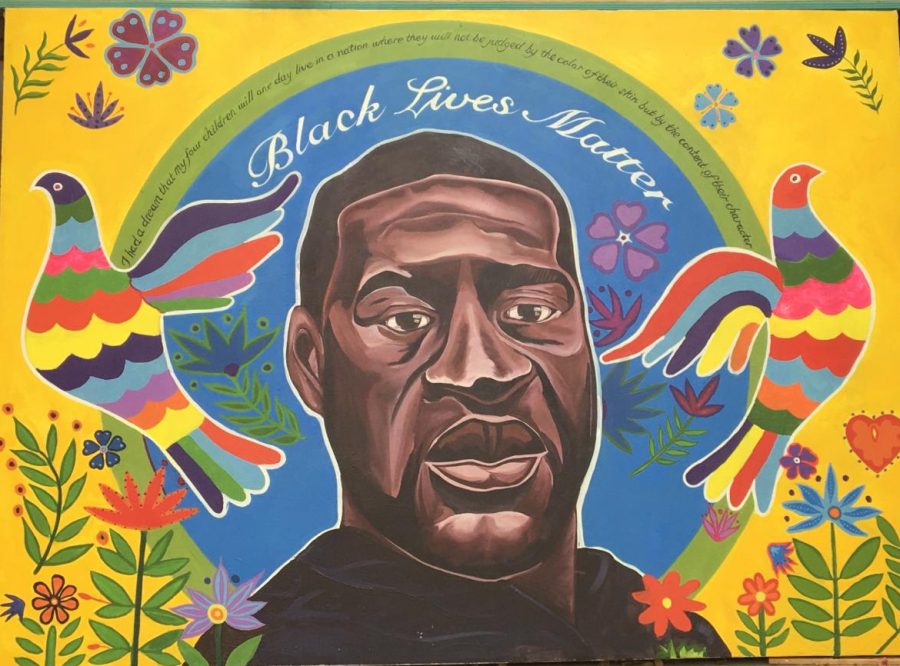The Vital Role of Social Media on the BLM Movement: How does it differ from the Civil Rights Movement?
A mural of George Floyd painted in Los Angeles, highlighting the community’s solidarity for the ongoing Black Lives Matter Movement.
2020: a COVID-19 pandemic, Black Lives Matter protests, and political discourse around racism in America–and its reform–are just some of the reasons this summer will mark history.
This year, many Americans took initiative by signing petitions, participating in protests, posting on social media, proposing legislative reform of policing and police brutality, and more. Though, this vast, national criticism of racism was not the first of its kind: the civil rights movement of the 1960s similarly featured gatherings, speeches, and protests of injustices and inequalities faced by Black Americans.
“You’re not supposed to be so blind with patriotism that you can’t face reality. Wrong is wrong, no matter who says it,” asserted prominent Civil Rights activist, Malcolm X in response to growing dissent of protests of segregation and systemic racism. These words — spoken in his speech entitled Prospects for Freedom (January 7, 1965) at the Militant Labor Forum, New York City–pose significant relevance to today’s discussion of American racism. While Malcom X was a figure in the Civil Rights era, took place mainly in the 1950s and 1960s, his voice and perspective is particularly poignant today as prominent politicians, sociologists, antiracist educators, and authors involve themselves in discourse around national institutions and racism as a whole.
Malcolm X’s notion emphasized that patriotism should not consist of ignorantly displaying the flag and proclaiming oneself as an unwaveringly American citizen. Patriotism, he said, cannot be defined by accepting the wrongs of the institutions and the realities of racism in America.
That, indeed, “wrong is wrong,” which must incite a vast critique of racist realities and systemic injustices. Over 5 decades later, his words ring alarmingly true – with the recent, tragic deaths of George Floyd, Breonna Taylor, and countless others.
Millions of Americans — angered and frustrated by the nation, and its systems, as a whole–protested the injustices of the recent killings of Black Americans by various police forces. Particularly, Generation Z (birth years of about 1996-2010) and millennials took to social media to voice their support for the Black Lives Matter Movement, and for the urgency of system-wide reform.
Despite nationwide and local quarantine-in-place orders, many opted to use social media as a platform to encourage conversation and support, while others attended socially-distanced protests with masks. In the words of Malcom X, “they faced reality,” which meant addressing the vast injustices of policing, racial profiling, and prejudices within governmental institutions, such as local police forces, where injustice manifests in over-policing in communities of color and racial discrimination. Young adults added stories and posts to their respective social media profiles, in order to emphasize the necessity to reform and rebuild corrupt systems operating on local, state, and national levels.
Mayfield students are no exception to utilizing social media in their efforts to incite change within governmental institutions and systems. Senior Karissa Ho ‘21 reflected that she has been “reading lots of literature written by Black authors recently, and [she] loves to share on social media in the hopes that others might have a chance to read them.” Ho ‘21 also noted that she has been “so inspired by those using social media accounts as a platform for educating themselves and others.”
In an interview with the New York Times, Princeton professor, Omar Wasow, highlighted that social media has completely altered, and perhaps bettered, the evolvement of the ‘Civil Rights Movement.’
“Part of what social media does is allow us to see a reality that has been entirely visible to some people and invisible to others. As those injustices become visible, meaningful change follows,” Wasow explained. Simply, social media has allowed for Black, Indigenous, and People of Color (BIPOC) to share their experiences with prejudice and discrimination. Additionally, social media platforms bring people together from diverse backgrounds to converse in important and relevant discourse. This forum of communication–especially popular among teenagers and young adults–has the capacity to share and receive information, speak with individuals about their experiences, share resources to educate oneself (anti-racist literature), and ways to donate to prominent organizations to support the movement. Therefore, Wasow’s statement highlights that the visibility of injustice permeates individuals who would rather not know or understand the impacts of systems and racist institutions, which catalyzes a responsive and positive “change.”
In comparison to the Civil Rights Era, individuals did not have access to technology or social media platforms, resulting in a lack of direct access to learn about experiences of BIPOC, or the prejudices they faced. Without this connection, many white Americans could not understand their complicity and upholding of the system as a whole, by maintaining silence in the movements to end segregation and systemic racism in the 1960s. Therefore, the primary difference in the two movements materialized in social media, as it brought individuals together from multitudes of states and backgrounds.


